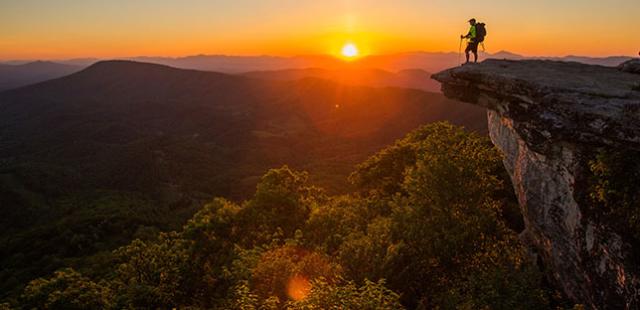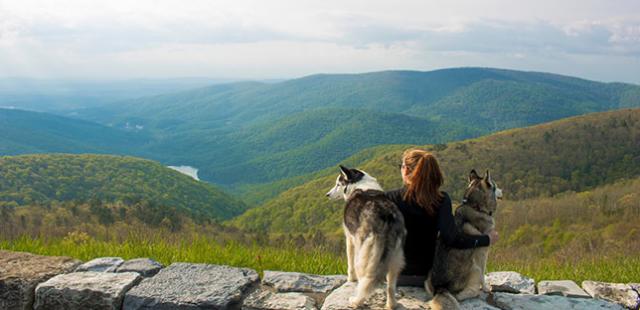Decades of research and archaeology has helped uncover facts and stories about the enslaved communities who once lived and worked at Virginia's most prominent historic sites. These findings have led to many recreated structures and dialogue that better represent the lives of the enslaved. These additions, which many believe were long overdue, have allowed the sites to tell a more comprehensive story of the past.
Notable sites telling the stories of their enslaved communities are featured below along with other new exhibits and helpful information for planning your next visit.
George Washington’s Mount Vernon—Fairfax

Mount Vernon
Home of the first U.S. President and Founding Father, Mount Vernon is perched high above the Potomac River outside of Washington D.C. Washington lived at this estate from age 22 until his death in 1799. More than 300 slaves worked the 8,000 acres over his lifetime, and he was the only slaveholding founder to eventually free his slaves in his will.
Step into Washington’s shoes and make his challenging decisions through the "Be Washington" exhibit. Explore the personal stories of the enslaved and gain insight into Washington’s evolving beliefs about slavery through the “Lives Bound Together” exhibit.
Know Before You Go: Ticketing and tours begin at the main entrance visitor center. Open 365 days a year, April to October from 9:00 a.m. to 5:00 p.m. and November to March from 9:00 a.m. to 4:00 p.m.
Thomas Jefferson’s Monticello—Charlottesville

Monticello
An autobiographical masterpiece, designed and redesigned for more than 40 years, Monticello lets you glimpse into Jefferson’s life and many accomplishments—as well as the paradox he lived by scribing “all men are created equal” while enslaving more than 600 people over the course of his life.
The mountaintop estate underwent a multi-year restoration of Mulberry Row, once the industrial “main street” of the 5,000-acre agricultural enterprise. Learn more through a slavery tour and visit the "Life of Sally Hemings" for a powerful exhibition about the enslaved woman who was made to have several of Jefferson's children and successfully negotiated their freedom.
Know Before You Go: Open daily, hours change seasonally. Arrive 30 minutes before your scheduled tour and park at the visitor center, where you’ll take a short shuttle to the house. After your house tour, explore additional tours and exhibits on the grounds included in the price of admission.
Thomas Jefferson’s Poplar Forest—Lynchburg

Poplar Forest
Jefferson owned several plantations, but only designed and built elaborate homes for himself at Monticello and Poplar Forest. The latter was his personal retreat, where he went to "indulge in the life of the mind and renew his personal creativity.” Explore its restoration and see how the neoclassical architecture of the octagonal house has been returned to Jefferson’s design.
Learn about those who labored for Jefferson’s happiness through a guided tour.
Know Before You Go: Poplar Forest’s more than 600 acres sits just outside of Lynchburg and the site is open year-round with varied seasonal hours. Access to the walking trails is free; admission is required elsewhere on the grounds.
James Madison’s Montpelier—Orange

Gilmore Cabin at Montpelier
Photo Credit: JD Thomas
Learn about Madison and his critical role in drafting the U.S. Bill of Rights, as well as his conflict with the institution of slavery, at Montpelier. The estate is where the fourth U.S. President and Father of the Constitution did much of his research and writing, and where his desk still sits today.
Archaeological research is returning the house and landscape to its original appearance. "The Mere Distinction of Colour" exhibition, located in the cellars and south yard, examines the paradox of America's founding era, exploring slavery to connect the past to the present through the lens of the Constitution.
Know Before You Go: Located 30 miles northeast of Charlottesville, Montpelier is open Thursdays through Mondays from 9:00 a.m. until 4:00 p.m. with guided house tours every 30 minutes beginning at 10:00 a.m.
James Monroe’s Highland—Charlottesville

Highland
Photo Credit: Jon Gregory @jonwgregory
Neighboring Monticello, Highland was home to James Monroe. A close friend and student of Jefferson, Monroe spent half of his 50 years of public service at this estate. Set on more than 500 acres, the house and gardens are nestled along a ridge with a landscape preserved much like Monroe would have known it.
Archaeologists found Monroe’s Guesthouse, originally built in 1818, where you can learn more about the lives of the free and enslaved residents of Highland.
Know Before You Go: Highland is open daily from 9:30 a.m. to 4 p.m.
Colonial Williamsburg—Williamsburg

Colonial Williamsburg
No place feels as alive and authentic as the streets of Virginia’s colonial capital, Williamsburg.
Step back in time with historical interpreters portraying real people who lived in 18th-century Williamsburg, such as Patrick Henry, George Washington, and the young Thomas Jefferson, along with lesser-known figures like Aggy of Turkey Island, an enslaved woman fighting for her family’s freedom.
Know Before You Go: Find free parking at the visitor’s center. Hop on a colonial carriage ride or explore by foot or shuttle bus. Check the daily event calendar and plan around your interests. The grounds and taverns are public, but an admission ticket is needed for events, performances, and building entries.
Keep planning your Historic Triangle trip with our complete guide to visiting Williamsburg.
Jamestown—Williamsburg

Jamestown Settlement
Photo Credit: Yatzuri Thomas @kidsquarantineandme
Virginia’s beginnings were established in 1607 at the first permanent English settlement in the new world. Explore the original settlement at Historic Jamestowne with onsite archaeology and exhibits telling the stories of European, Native American, and African cultures. Visit the adjacent Jamestown Settlement museum for more exhibits, films, and recreated living history.
Archaeology at Historic Jamestowne recently uncovered two important figures in America’s early history: the possible remains of George Yeardley, Virginia’s first governor, as well as the site occupied by Angela, the first recorded African to arrive in the new world.
Know Before You Go: Plan to visit both Historic Jamestowne and Jamestown Settlement, adjacent to each other along the James River in Williamsburg. Both are open daily from 9:00 a.m. to 5:00 p.m.
Find more impactful museums and locations with our guide to Black History sites in Virginia.

